| کد مقاله | کد نشریه | سال انتشار | مقاله انگلیسی | نسخه تمام متن |
|---|---|---|---|---|
| 2602402 | 1562708 | 2016 | 9 صفحه PDF | دانلود رایگان |
• Long-term exposure to AgNPs induce anchorage independent colony formation and epithelial mesenchymal transition.
• AgNPs stimulate anti-apoptosis/anoikis resistance by complex regulation of p53, p38, JNK, and ERK.
• AgNPs enhance in vitro malignant cell transformation in human non-tumorigenic lung cells.
• AgNPs induce metastasis characteristics including cell migration and invasion.
To predict carcinogenic potential of AgNPs on the respiratory system, BEAS-2B cells (human bronchial epithelial cells) were chronically exposed to low- and non-cytotoxic dose (0.13 and 1.33 μg/ml) of AgNPs for 4 months (#40 passages). To assess malignant cell transformation of chronic exposure to AgNPs, several bioassays including anchorage independent agar colony formation, cell migration/invasion assay, and epithelial-mesenchymal transition (EMT) were performed in BEAS-2B cells. Chronic exposure to AgNPs showed a significant increase of anchorage independent agar colony formation and cell migration/invasion. EMT, which is the loss of epithelial markers (E-Cadherin and Keratin) and the gain of mesenchymal marker (N-cadherin and Vimentin), was induced by chronic exposure to AgNPs. These responses indicated that chronic exposure to AgNPs could acquire characteristics of tumorigenic cells from normal BEAS-2B cells. In addition, caspase-3, p-p53, p-p38, and p-JNK were significantly decreased, while p-ERK1/2 was significantly increased. MMP-9 related to cell migration/invasion was upregulated, while a MMP-9 inhibitor, TIMP-1 was down-regulated. These results indicated that BEAS-2B cells exposed to AgNPs could induce anti-apoptotic response/anoikis resistance, and cell migration/invasion by complex regulation of MAPK kinase (p38, JNK, and ERK) and p53 signaling pathways. Therefore, we suggested that long-term exposure to low-dose of AgNPs could enhance malignant cell transformation in non-tumorigenic BEAS-2B cells. Our findings provide useful information needed to assess the carcinogenic potential of AgNPs.
Journal: Toxicology in Vitro - Volume 37, December 2016, Pages 41–49
